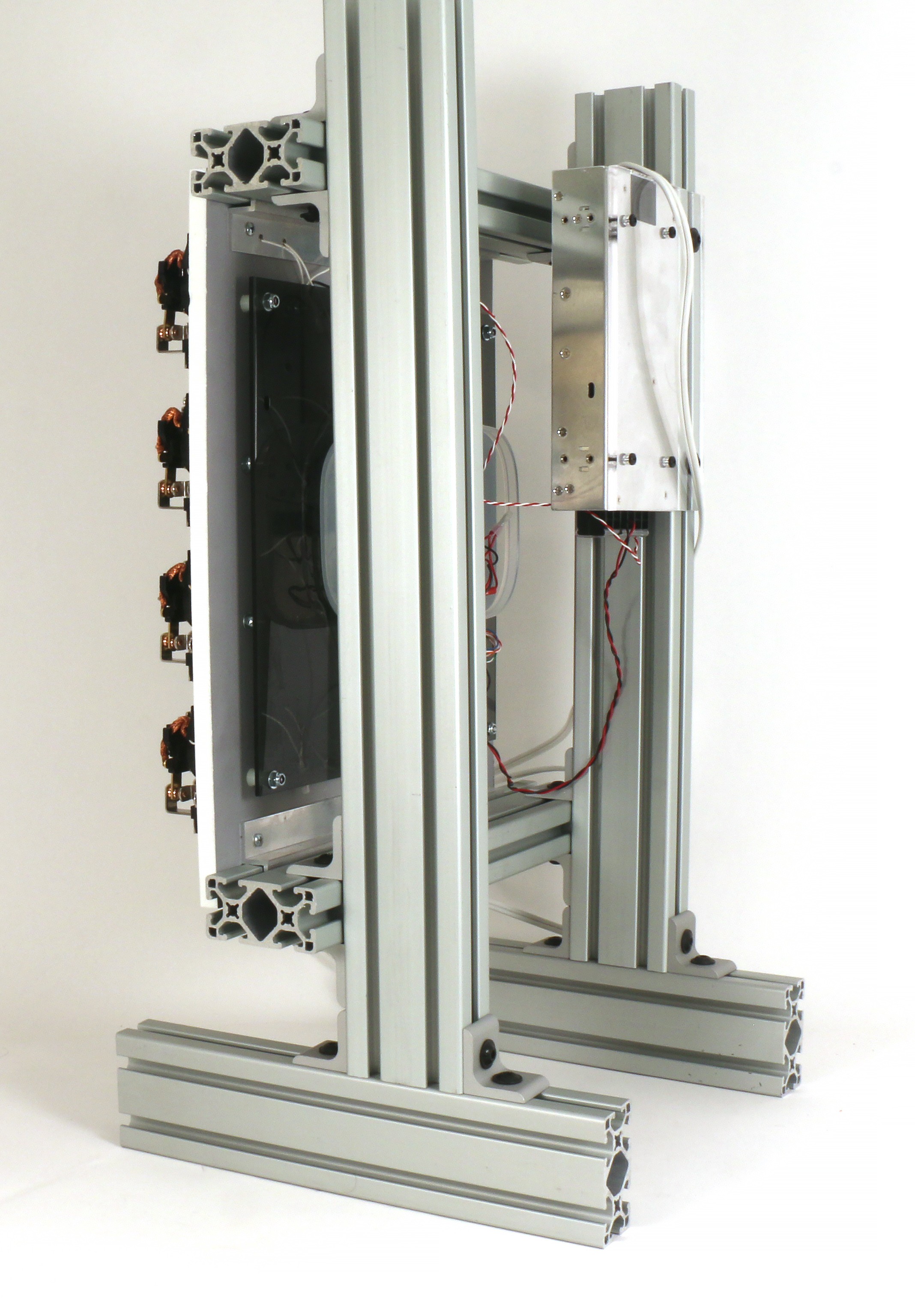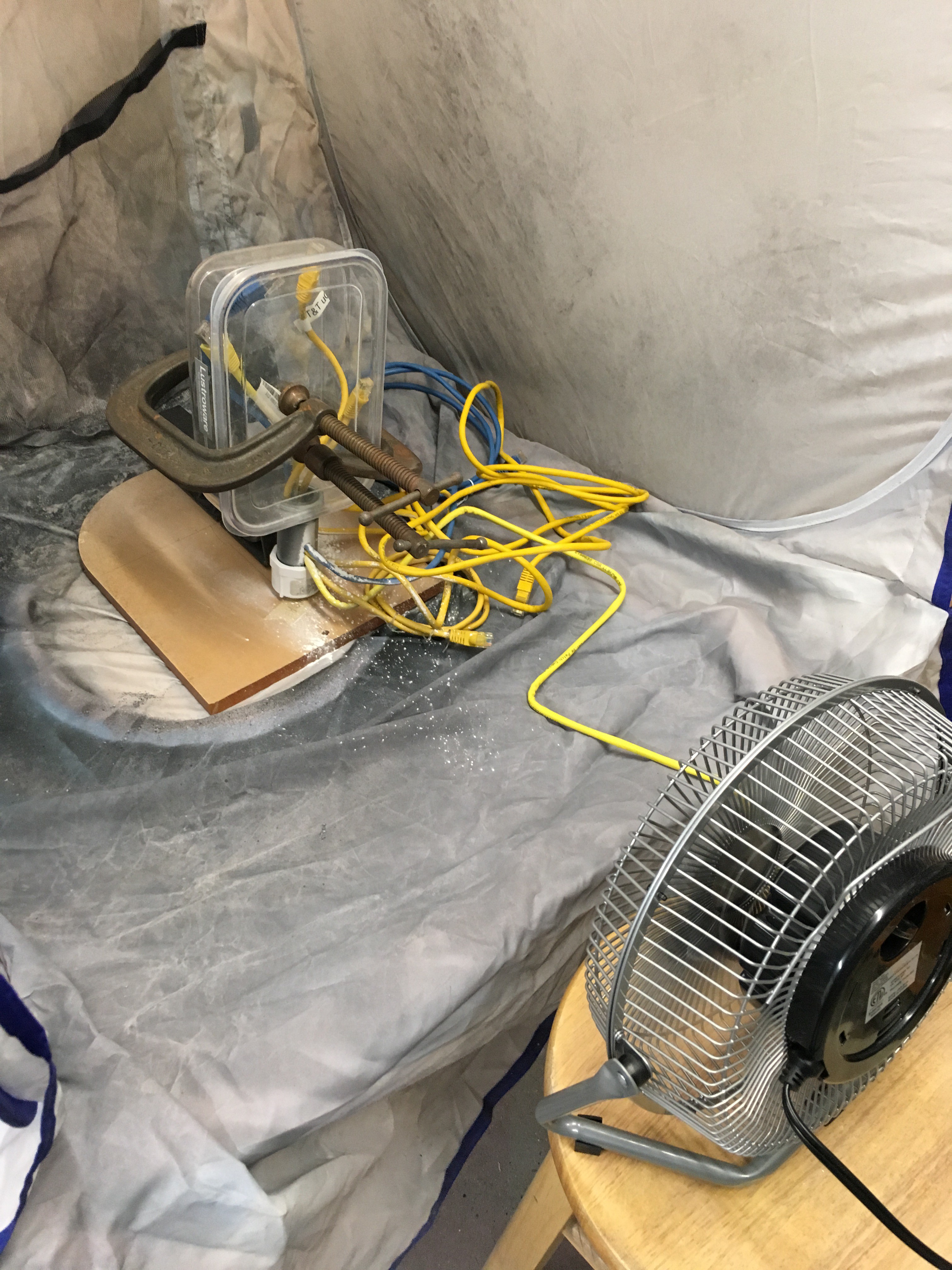Well, summer, life, and various project setbacks have delayed log entries here, though much progress has been made, too. After assembling the relays on the panel, I attached the small Tupperware box containing the PCB (to protect it, at least partially, from the elements and curios fingers when on display) to the back, only to realize that I could no longer slide the panel back onto the frame; the box collides with the uprights. So, I replaced the 1.5" x 1.5" horizontal supports with 1.5" x 3" ones (the same profile I'm using for the uprights and feet), and now there's plenty of room:

The power supply in the upper-right is an example of the actual one I plan to use in the finished piece (well, x8). The piece of smoked acrylic filling most of the rear of the panel protects all the wires running from the box to the relays; with frequent assembly and disassembly, it would be easy for them to get caught on something. The acrylic also hides them, resulting in a much cleaner look from the rear. I think I'll use white acrylic in the final piece, though.
So, you'd think with a complete mechanical assembly, PCB, and power supply this thing should be ready to rumble. And, you'd be right:
Keep in mind this was just a test to see if everything was connected (and properly), and to see what sorts of sounds and frequencies I can get out of a panel. Still, multiply it by 64 and at least you've got quite a racket. Hopefully, the composers associated with this project will be able to make it a pleasant, or at least, entertaining racket.
Naturally, on the heals of my success I blew up the PCB by shorting the Vcc and ground rails together while measuring voltage under the load of operation. I reflowed another one (remember, I have 10 ;-) ) and made a note to put the test pins for Vcc and ground farther apart on v2 of the PCB (they were adjacent on the test header of v1).
I also decided my original idea of just drilling two or three holes in the side of the box to feed wires to the PCB wasn't going to cut it at scale.

Even though I could make them cleaner, I'm seriously considering bringing the piece to Burning Man and the dust on the playa is like talcum powder and gets everywhere. The RJ45 connectors (for the RS485 network) hanging out the side were just begging for infiltration. I decided on this approach:

The idea is to feed all four RJ45 cables (two for the relays and two for the network) through that gray, schedule 40 nipple (pipe) into the box, then guide them into the slot milled in the side of the nipple. This will allow me to screw a cap on the end, creating a tight (though not air or water tight) fit. The only question is, with the box oriented vertically on the panel, will the small gaps between the cables and pipe allow powder to be blown into the pipe and then up into the box.
To test it, I placed the assembly of box, pipe, and cables in my collapsible spray booth and used a desk fan to blow talcum powder at it:

No talc made it into the box, so this is the approach I'm going with (however unscientific it may be).
I'm also moving all the RJ45 connectors to one edge of the PCB in v2 so I don't have to bend them so sharply as with v1:

The new board will fit in the box with the connector edge horizontal and pointing down, towards the pipe, allowing the cables to flow almost directly into their jacks.
Other things addressed in v2 are correctly wiring the JTAG connector; a new RS485 transceiver as the initial one was end-of-lifed by Maxim as soon as I got the v1 boards from China; and, a new DC-DC converter as the tiny one I used in v1 was bridging too easily during reflow, and the bridges are hard to fix since they're under the part, so I switched to a larger, but through-hole converter that shouldn't give me any problems.
I probably won't have anything to update until I get the v2 PCBs back, hopefully in a couple of weeks. The layout's done, but I'm still proofing it.
 Involute
Involute
Discussions
Become a Hackaday.io Member
Create an account to leave a comment. Already have an account? Log In.